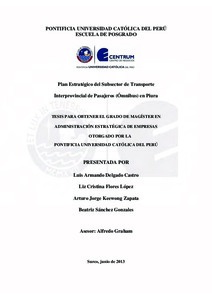| dc.contributor.advisor | Graham Rojas, Alfredo | |
| dc.contributor.author | Delgado Castro, Luis Armando | |
| dc.contributor.author | Flores López, Liz Cristina | |
| dc.contributor.author | Keewong Zapata, Arturo Jorge | |
| dc.contributor.author | Sánchez Gonzales, Beatriz | |
| dc.date.accessioned | 2019-05-10T20:57:12Z | |
| dc.date.available | 2019-05-10T20:57:12Z | |
| dc.date.created | 2013-06 | |
| dc.date.issued | 2019-05-10 | |
| dc.identifier.uri | http://hdl.handle.net/20.500.12404/14186 | |
| dc.description.abstract | La presente tesis elabora el plan estratégico del subsector de transporte interprovincial
de pasajeros (ómnibus) en Piura, que tiene por finalidad impulsar su desarrollo sostenible y
lograr un enfoque integral para el transporte interprovincial en un horizonte de 15 años.
Piura es una región exportadora de harina de pescado, limones, plátanos, aceites
vegetales, mangos, uvas y conchas de abanico; asimismo, es exportadora de materias primas
agrícolas, industria minera, hidrocarburos, construcción, turismo y gastronomía. Todas estas
actividades han permitido que Piura crezca económicamente en los últimos años; sin
embargo, el subsector de transporte interprovincial de pasajeros (ómnibus) no ha crecido al
mismo nivel. Esto ha ocasionado que se generen debilidades en los factores económico,
social y medioambiental. Este subsector tiene posibilidades de crecer en forma sostenible a
nivel regional; no obstante, existen limitaciones que aún deben superarse, tales como el
crecimiento del mercado informal, la falta de visión estratégica de las empresas de transporte
interprovincial, los altos costos operativos y la inadecuada regulación de la ley del servicio
del transporte interprovincial. Tras el análisis de las fuerzas identificadas, se sugiere una
estrategia genérica competitiva de enfoque en costos, sin perjuicio a la calidad, seguridad y
protección del medio ambiente. Esta estrategia permitirá alcanzar la visión propuesta para el
transporte interprovincial de pasajeros (ómnibus) en Piura.
Para implementar este plan estratégico, se requiere de los siguientes elementos: (a)
grado de inversión, (b) infraestructura, (c) leyes regulatorias para el medio ambiente, (d)
aplicación de fuertes medidas para combatir la informalidad, y (e) integración de los actores
del transporte interprovincial, bajo un organismo que permita desarrollar estrategias y tomar
decisiones en forma conjunta. Por lo tanto, la creación de un clúster permitirá mejorar la
competitividad y rentabilidad del subsector de transporte interprovincial de pasajeros en la
región Piura. | es_ES |
| dc.description.abstract | The following study develops the strategic plan for the interprovincial transport
subsector in Piura which aims to boost its sustainable development and achieve a
comprehensive approach for the interprovincial transport sector in the next 15 years.
Piura is a region that exports fishmeal, lemons, bananas, vegetable oils, mangoes,
grapes and scallops; also it exports agricultural raw materials, mining industry, hydrocarbons,
construction, tourism and gastronomy. All these activities have allowed Piura to grow
economically in the last few years; however, the interprovincial passenger transport subsector
(buses) has not grown at the same rate. This has brought about weaknesses to develop in the
economic, social and environmental factors. This subsector has possibilities of growing in a
sustainable manner and also regionally; nevertheless there are limitations that must be
overcome, such as the growth of the informal market, the lack of strategic vision of the
interprovincial transport companies, the high operating costs and the inadequate regulation of
the interprovincial transport law. After the analysis of the identified forces, a generic
competitive strategy focusing on costs is suggested, notwithstanding the quality, security and
protection of the environment. This strategy will allow us the reaching of the proposed vision
for the interprovincial passenger transport in Piura.
In order to implement this strategic plan the following elements are required: (a)
investment grade, (b) infrastructure, (c) regulatory laws for the environment, (d) the
enforcement of strong measures to fight the informal sector, and (e) the integration of all the
stakeholders in interprovincial transport, under an organism that will allow strategies to be
developed and decisions to be taken jointly. The creation of a cluster will therefore allow an
improvement in the competitiveness and profitability of the interprovincial passenger
subsector in the Piura region. | es_ES |
| dc.language.iso | spa | es_ES |
| dc.publisher | Pontificia Universidad Católica del Perú | es_ES |
| dc.rights | info:eu-repo/semantics/openAccess | es_ES |
| dc.rights.uri | http://creativecommons.org/licenses/by-nc-nd/2.5/pe/ | * |
| dc.subject | Transporte terrestre--Perú--Piura | es_ES |
| dc.subject | Planificación estratégica | es_ES |
| dc.title | Plan estratégico del subsector de transporte interprovincial de pasajeros (omnibus) en Piura | es_ES |
| dc.type | info:eu-repo/semantics/masterThesis | es_ES |
| thesis.degree.name | Maestro en Administración Estratégica de Empresas | es_ES |
| thesis.degree.level | Maestría | es_ES |
| thesis.degree.grantor | Pontificia Universidad Católica del Perú. CENTRUM | es_ES |
| thesis.degree.discipline | Administración Estratégica de Empresas | es_ES |
| renati.advisor.dni | 42446831 | |
| renati.author.dni | 02878372 | |
| renati.author.dni | 02866156 | |
| renati.author.dni | 03489393 | |
| renati.author.dni | 03878919 | |
| renati.discipline | 413307 | es_ES |
| renati.level | https://purl.org/pe-repo/renati/level#maestro | es_ES |
| renati.type | https://purl.org/pe-repo/renati/type#tesis | es_ES |
| dc.publisher.country | PE | es_ES |
| dc.subject.ocde | https://purl.org/pe-repo/ocde/ford#5.02.04 | es_ES |






